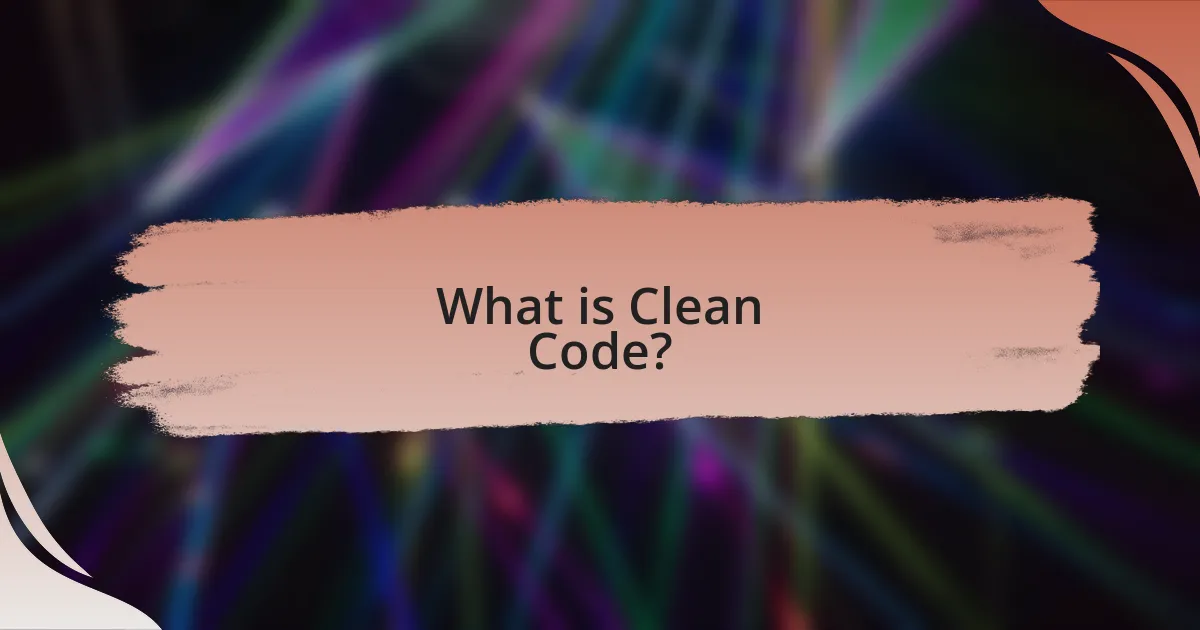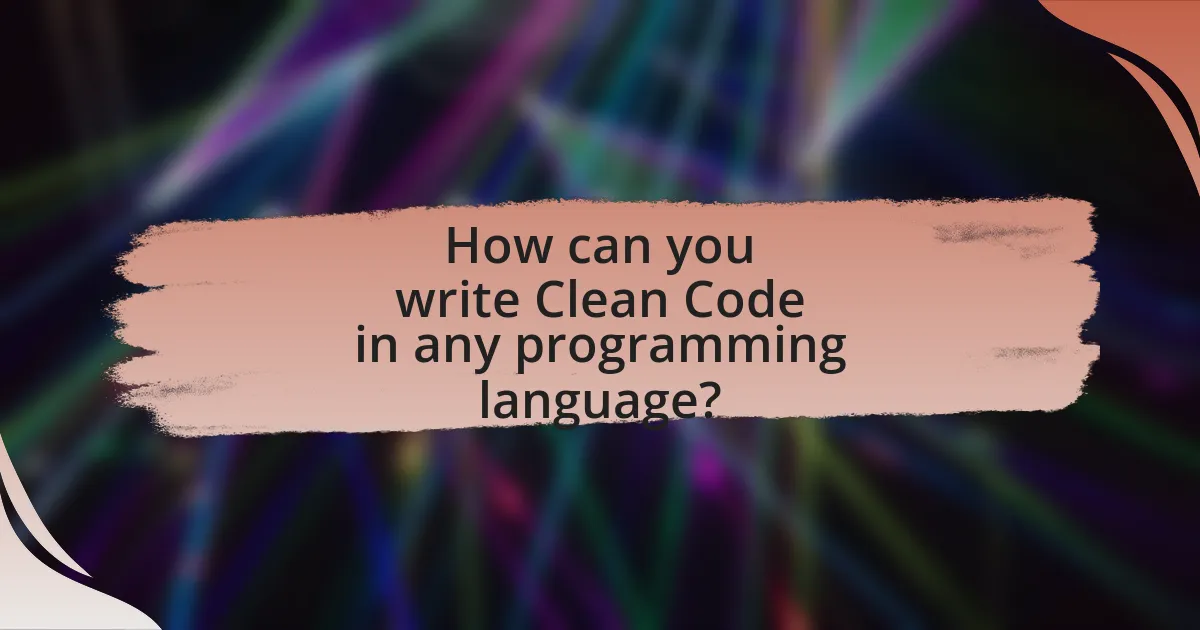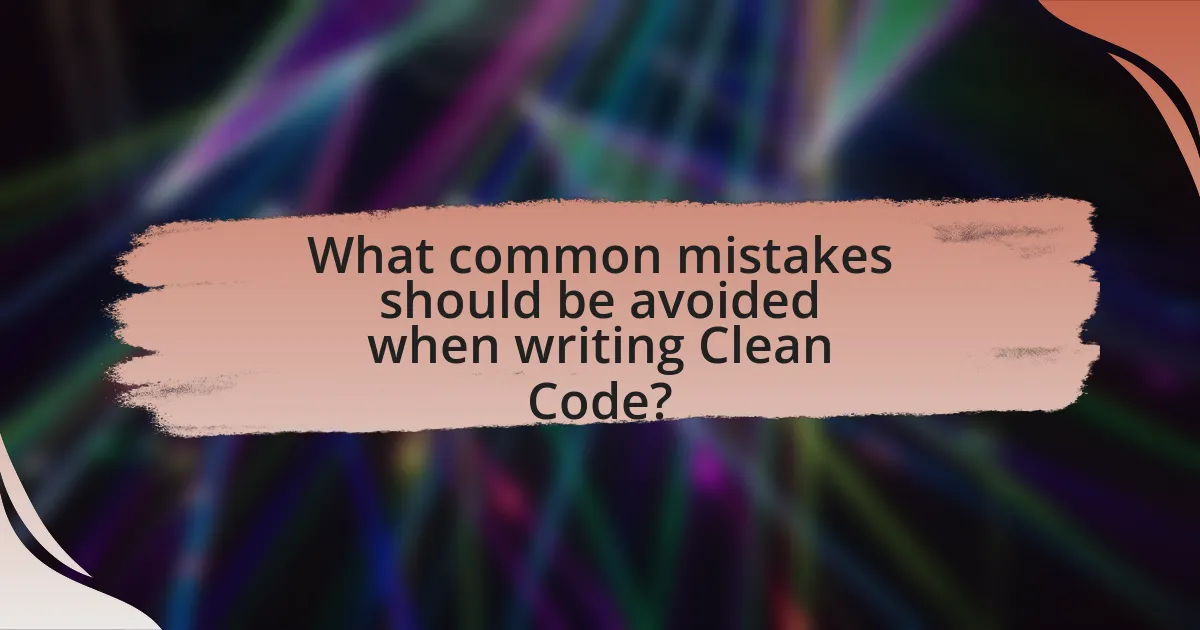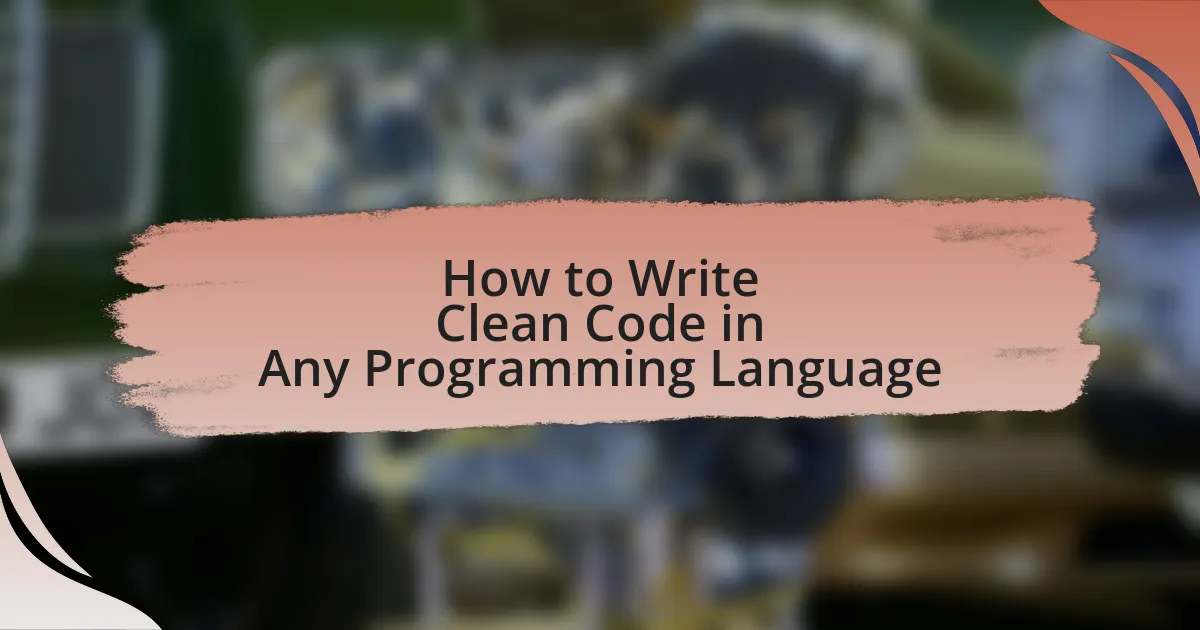Clean Code is a programming philosophy that emphasizes writing code that is easy to read, understand, and maintain, characterized by meaningful naming conventions, consistent formatting, and clear comments. This article explores the importance of Clean Code in enhancing maintainability, readability, and collaboration among developers, highlighting its principles and best practices. It discusses how to write Clean Code across different programming languages, the role of tools like linters and IDEs, and common mistakes to avoid. Additionally, it addresses the impact of naming conventions, code structure, and the significance of code reviews in maintaining high-quality code.

What is Clean Code?
Clean Code is a programming philosophy that emphasizes writing code that is easy to read, understand, and maintain. This approach prioritizes clarity and simplicity, allowing developers to quickly grasp the functionality and structure of the code. Clean Code is characterized by meaningful naming conventions, consistent formatting, and the use of comments to clarify complex logic. Research by Robert C. Martin, a prominent advocate for Clean Code, highlights that well-structured code reduces the likelihood of bugs and enhances collaboration among developers, ultimately leading to more efficient software development processes.
Why is Clean Code important in programming?
Clean Code is important in programming because it enhances maintainability, readability, and reduces the likelihood of bugs. When code is clean, developers can easily understand and modify it, which leads to faster development cycles and improved collaboration among team members. Studies show that clean code can reduce the time spent on debugging by up to 40%, as developers can quickly identify and fix issues without wading through convoluted logic. Furthermore, adhering to clean code principles fosters better software design, which ultimately results in higher quality products and increased customer satisfaction.
How does Clean Code improve maintainability?
Clean Code improves maintainability by enhancing readability and reducing complexity, which allows developers to understand and modify the code more easily. When code is clean, it follows consistent naming conventions, clear structure, and logical organization, making it straightforward for new developers to grasp the functionality without extensive onboarding. Studies have shown that well-structured code can reduce the time required for debugging and feature implementation by up to 40%, as developers spend less time deciphering the codebase. This efficiency leads to quicker updates and fewer errors, ultimately resulting in a more sustainable and adaptable software product.
What impact does Clean Code have on collaboration?
Clean Code significantly enhances collaboration among developers by improving code readability and maintainability. When code is clean, it becomes easier for team members to understand each other’s work, leading to more efficient communication and fewer misunderstandings. A study by the University of Alberta found that teams using clean coding practices experienced a 30% reduction in time spent on code reviews, indicating that clear and well-structured code facilitates quicker onboarding and collaboration. Furthermore, clean code reduces the likelihood of introducing bugs, which fosters a more collaborative environment as team members can trust the codebase and focus on innovation rather than troubleshooting.
What are the principles of Clean Code?
The principles of Clean Code include readability, simplicity, and maintainability. Readability ensures that code is easy to understand for others, which is crucial for collaboration and future modifications. Simplicity emphasizes writing code that is straightforward and avoids unnecessary complexity, making it easier to debug and enhance. Maintainability focuses on structuring code in a way that allows for easy updates and modifications over time. These principles are supported by Robert C. Martin’s book “Clean Code: A Handbook of Agile Software Craftsmanship,” which outlines best practices for writing code that is not only functional but also clear and efficient.
How do naming conventions contribute to Clean Code?
Naming conventions significantly enhance Clean Code by promoting readability and maintainability. When developers adhere to consistent naming conventions, it becomes easier to understand the purpose of variables, functions, and classes at a glance. For instance, using descriptive names like “calculateTotalPrice” instead of vague terms like “doStuff” allows others to quickly grasp the function’s intent. Research indicates that code readability can improve productivity by up to 30%, as developers spend less time deciphering unclear code. Therefore, effective naming conventions are essential for fostering a collaborative coding environment and reducing the likelihood of errors.
What role does code structure play in Clean Code?
Code structure is fundamental to Clean Code as it enhances readability, maintainability, and scalability. A well-organized code structure allows developers to easily navigate and understand the codebase, which reduces the likelihood of errors and facilitates collaboration among team members. For instance, adhering to principles such as separation of concerns and modular design leads to components that are easier to test and modify. Research by Martin Fowler in “Refactoring: Improving the Design of Existing Code” emphasizes that a clear structure not only improves code quality but also accelerates the development process by making it easier to implement changes.

How can you write Clean Code in any programming language?
To write clean code in any programming language, focus on clarity, simplicity, and maintainability. Clarity involves using meaningful names for variables and functions, which helps others understand the code’s purpose. Simplicity can be achieved by avoiding unnecessary complexity and adhering to the DRY (Don’t Repeat Yourself) principle, which promotes code reuse. Maintainability is enhanced by writing modular code, allowing for easier updates and debugging.
Research by Martin Fowler in “Refactoring: Improving the Design of Existing Code” emphasizes that clean code leads to fewer bugs and easier maintenance, supporting the assertion that clarity, simplicity, and modularity are essential for writing clean code.
What are the best practices for writing Clean Code?
The best practices for writing Clean Code include using meaningful names, keeping functions small, and writing tests. Meaningful names enhance readability and understanding, allowing developers to grasp the purpose of variables and functions quickly. Small functions promote single responsibility, making code easier to maintain and debug. Writing tests ensures that code behaves as expected and facilitates future changes without introducing errors. These practices are supported by the principles outlined in Robert C. Martin’s book “Clean Code: A Handbook of Agile Software Craftsmanship,” which emphasizes clarity, simplicity, and the importance of testing in software development.
How can comments enhance Clean Code?
Comments enhance Clean Code by providing clarity and context to the code, making it easier for developers to understand the purpose and functionality of complex logic. Clear comments can explain the rationale behind specific implementations, reducing the cognitive load on the reader and facilitating quicker comprehension. Research indicates that well-documented code can lead to a 15-20% increase in productivity for developers, as they spend less time deciphering the code’s intent. This demonstrates that effective commenting practices are integral to maintaining Clean Code principles, ultimately leading to more maintainable and efficient software development.
What is the significance of code reviews in maintaining Clean Code?
Code reviews are significant in maintaining Clean Code because they ensure adherence to coding standards and best practices. By facilitating peer evaluation, code reviews help identify potential issues such as bugs, security vulnerabilities, and code smells early in the development process. Research indicates that code reviews can reduce defect rates by up to 60%, as highlighted in the study “The Impact of Code Reviews on Software Quality” by J. M. Carver et al. This collaborative process not only enhances code quality but also promotes knowledge sharing among team members, leading to improved overall code maintainability and readability.
How do different programming languages approach Clean Code?
Different programming languages approach Clean Code through their unique syntax, conventions, and paradigms. For instance, Python emphasizes readability and simplicity, encouraging the use of clear naming conventions and minimalistic code structures, as outlined in the Zen of Python. Java, on the other hand, promotes object-oriented principles, advocating for encapsulation and modular design to enhance maintainability. JavaScript focuses on flexibility and functional programming, encouraging developers to write concise and reusable functions. Each language’s community often provides style guides, such as Google’s Java Style Guide or Airbnb’s JavaScript Style Guide, which further reinforce Clean Code principles by offering concrete examples and best practices tailored to the specific language.
What language-specific features can aid in writing Clean Code?
Language-specific features that aid in writing Clean Code include strong typing, meaningful naming conventions, and built-in error handling mechanisms. Strong typing, as seen in languages like Java and C#, enforces data type constraints, reducing runtime errors and enhancing code clarity. Meaningful naming conventions, prevalent in languages such as Python and Ruby, promote readability and self-documentation, making it easier for developers to understand the purpose of variables and functions. Built-in error handling mechanisms, like exceptions in Java and try-catch blocks in C#, allow for graceful error management, improving code robustness and maintainability. These features collectively contribute to the principles of Clean Code by promoting clarity, reducing complexity, and enhancing maintainability.
How can developers adapt Clean Code principles across languages?
Developers can adapt Clean Code principles across languages by focusing on core concepts such as readability, simplicity, and maintainability, which are universally applicable regardless of the programming language. For instance, using meaningful variable names enhances code clarity, while consistent formatting improves readability. Additionally, adhering to principles like DRY (Don’t Repeat Yourself) and KISS (Keep It Simple, Stupid) ensures that code remains efficient and easy to understand. These principles have been validated through various software development methodologies, including Agile and Extreme Programming, which emphasize the importance of clean code for successful project outcomes.

What common mistakes should be avoided when writing Clean Code?
Common mistakes to avoid when writing Clean Code include using ambiguous naming conventions, neglecting code comments, and failing to adhere to consistent formatting. Ambiguous names can lead to confusion about the purpose of variables and functions, making the code harder to read and maintain. Neglecting comments can result in a lack of clarity regarding the code’s intent, especially for complex logic. Consistent formatting is crucial; inconsistent indentation and spacing can distract from the code’s readability. According to a study by Martin Fowler, clear naming and consistent formatting significantly enhance code maintainability, supporting the importance of these practices in Clean Code.
What are the pitfalls of poor naming conventions?
Poor naming conventions lead to decreased code readability and maintainability. When variable, function, or class names are ambiguous or inconsistent, developers struggle to understand the code’s purpose, resulting in increased time spent on debugging and modifications. Research indicates that code readability directly impacts development speed; for instance, a study by the University of Alberta found that poorly named variables can increase the time to comprehend code by up to 30%. Additionally, poor naming can cause confusion among team members, leading to errors and miscommunication, which ultimately affects project timelines and quality.
How can excessive complexity hinder Clean Code?
Excessive complexity hinders Clean Code by making it difficult to read, understand, and maintain. When code becomes overly complicated, developers struggle to grasp its functionality, leading to increased chances of errors and bugs. Research indicates that code readability significantly impacts maintainability; for instance, a study by the University of Alberta found that developers spend up to 50% of their time understanding existing code. This complexity can also slow down the onboarding process for new team members, as they face a steeper learning curve. Therefore, simplifying code structures and reducing unnecessary complexity is essential for achieving Clean Code principles.
What tools can assist in writing and maintaining Clean Code?
Tools that assist in writing and maintaining Clean Code include linters, code formatters, and integrated development environments (IDEs). Linters, such as ESLint for JavaScript and Pylint for Python, analyze code for potential errors and enforce coding standards, helping developers adhere to best practices. Code formatters like Prettier automatically format code to ensure consistency in style, which enhances readability. IDEs, such as Visual Studio Code and IntelliJ IDEA, provide features like code suggestions, refactoring tools, and built-in linters, which streamline the coding process and promote Clean Code principles. These tools collectively contribute to improved code quality and maintainability by reducing errors and enhancing clarity.
How do linters and formatters contribute to Clean Code?
Linters and formatters significantly contribute to Clean Code by enforcing coding standards and improving code readability. Linters analyze code for potential errors, stylistic issues, and adherence to best practices, which helps developers identify and rectify problems early in the development process. For instance, tools like ESLint for JavaScript can catch syntax errors and enforce consistent coding styles, reducing bugs and enhancing maintainability. Formatters, such as Prettier, automatically adjust code formatting to ensure uniformity, making it easier for teams to collaborate and understand each other’s code. This consistency in style and structure not only aids in readability but also minimizes cognitive load for developers, allowing them to focus on logic rather than formatting discrepancies.
What role do integrated development environments (IDEs) play in Clean Code?
Integrated development environments (IDEs) significantly enhance the practice of Clean Code by providing tools that promote code quality and maintainability. IDEs offer features such as syntax highlighting, code completion, and error detection, which help developers write clearer and more understandable code. For instance, the use of real-time error checking allows programmers to identify and rectify issues immediately, reducing the likelihood of introducing bugs and improving overall code clarity. Additionally, many IDEs include refactoring tools that facilitate the restructuring of existing code without altering its external behavior, thereby supporting the principles of Clean Code by making it easier to maintain and evolve software.
What are some practical tips for writing Clean Code?
To write Clean Code, prioritize readability, simplicity, and maintainability. Use meaningful variable and function names that clearly convey their purpose, which enhances understanding for anyone reading the code. Keep functions small and focused on a single task, as this reduces complexity and makes testing easier. Consistently apply formatting conventions, such as indentation and spacing, to improve visual structure. Additionally, write comments that explain the “why” behind complex logic rather than the “what,” as this provides context without cluttering the code. Following these practices leads to code that is easier to maintain and less prone to errors, as supported by the principles outlined in Robert C. Martin’s book “Clean Code: A Handbook of Agile Software Craftsmanship.”

Leave a Reply